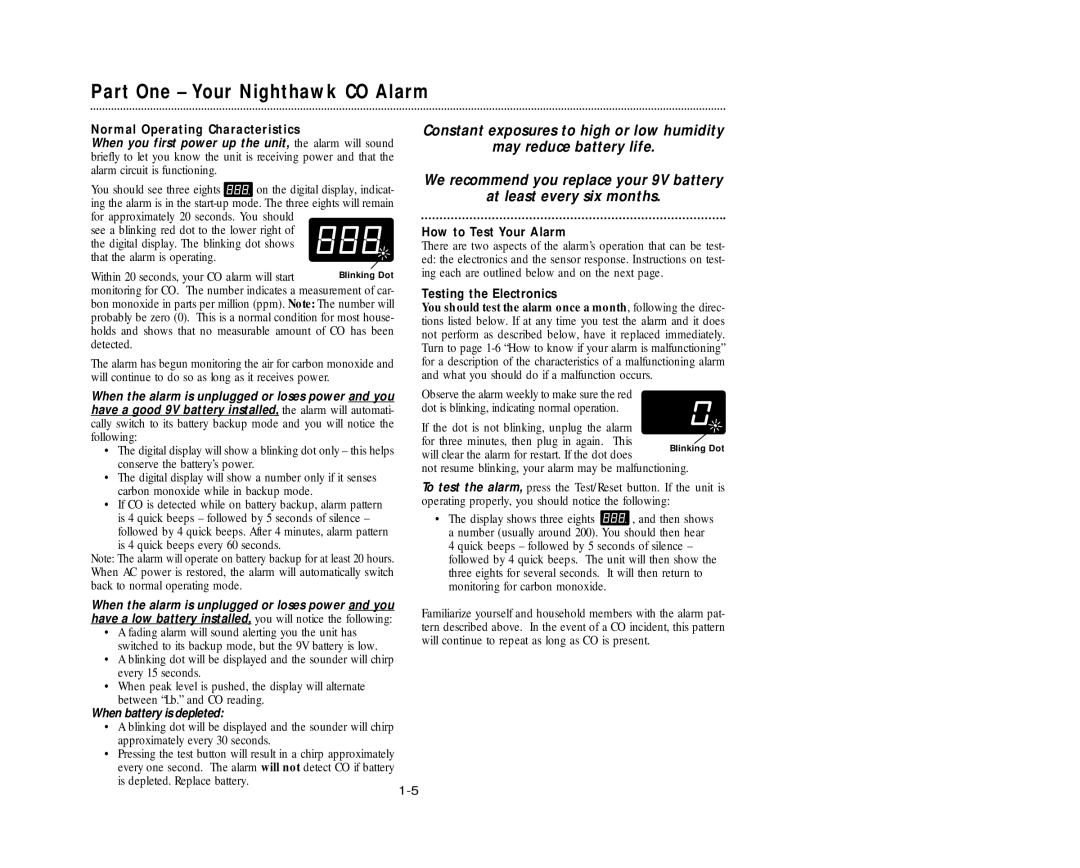
Part One – Your Nighthawk CO Alarm
Normal Operating Characteristics
When you first power up the unit, the alarm will sound briefly to let you know the unit is receiving power and that the alarm circuit is functioning.
You should see three eights ![]() on the digital display, indicat- ing the alarm is in the
on the digital display, indicat- ing the alarm is in the
see a blinking red dot to the lower right of the digital display. The blinking dot shows that the alarm is operating.
Within 20 seconds, your CO alarm will start
monitoring for CO. The number indicates a measurement of car- bon monoxide in parts per million (ppm). Note: The number will probably be zero (0). This is a normal condition for most house- holds and shows that no measurable amount of CO has been detected.
The alarm has begun monitoring the air for carbon monoxide and will continue to do so as long as it receives power.
When the alarm is unplugged or loses power and you have a good 9V battery installed, the alarm will automati- cally switch to its battery backup mode and you will notice the following:
•The digital display will show a blinking dot only – this helps conserve the battery’s power.
•The digital display will show a number only if it senses carbon monoxide while in backup mode.
•If CO is detected while on battery backup, alarm pattern is 4 quick beeps – followed by 5 seconds of silence – followed by 4 quick beeps. After 4 minutes, alarm pattern is 4 quick beeps every 60 seconds.
Note: The alarm will operate on battery backup for at least 20 hours. When AC power is restored, the alarm will automatically switch back to normal operating mode.
When the alarm is unplugged or loses power and you have a low battery installed, you will notice the following:
•A fading alarm will sound alerting you the unit has switched to its backup mode, but the 9V battery is low.
•A blinking dot will be displayed and the sounder will chirp every 15 seconds.
•When peak level is pushed, the display will alternate between “Lb.” and CO reading.
When battery is depleted:
•A blinking dot will be displayed and the sounder will chirp approximately every 30 seconds.
•Pressing the test button will result in a chirp approximately every one second. The alarm will not detect CO if battery is depleted. Replace battery.
Constant exposures to high or low humidity
may reduce battery life.
We recommend you replace your 9V battery
at least every six months.
How to Test Your Alarm
There are two aspects of the alarm’s operation that can be test- ed: the electronics and the sensor response. Instructions on test- ing each are outlined below and on the next page.
Testing the Electronics
You should test the alarm once a month, following the direc- tions listed below. If at any time you test the alarm and it does not perform as described below, have it replaced immediately. Turn to page
Observe the alarm weekly to make sure the red dot is blinking, indicating normal operation.
If the dot is not blinking, unplug the alarm for three minutes, then plug in again. This will clear the alarm for restart. If the dot does
not resume blinking, your alarm may be malfunctioning.
To test the alarm, press the Test/Reset button. If the unit is operating properly, you should notice the following:
•The display shows three eights ![]() , and then shows a number (usually around 200). You should then hear 4 quick beeps – followed by 5 seconds of silence – followed by 4 quick beeps. The unit will then show the three eights for several seconds. It will then return to monitoring for carbon monoxide.
, and then shows a number (usually around 200). You should then hear 4 quick beeps – followed by 5 seconds of silence – followed by 4 quick beeps. The unit will then show the three eights for several seconds. It will then return to monitoring for carbon monoxide.
Familiarize yourself and household members with the alarm pat- tern described above. In the event of a CO incident, this pattern will continue to repeat as long as CO is present.
